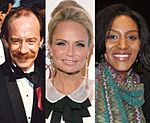Elmo's World facts for kids
Quick facts for kids Elmo's World |
|
|---|---|
| Genre | Children's show Educational Puppet show Segment |
| Written by | Judy Freudberg (1998-2009) |
| Opening theme | Elmo's World Theme Song (sung to "Elmo's Song" prior to 2017) |
| Ending theme | The Close Song (usually sung to the tune of "Jingle Bells") (1998–2009) The Happy Dance (2017–present) |
| Country of origin | United States |
| Original language(s) | English |
| No. of episodes | 127 (including specials) |
| Production | |
| Running time | 15 minutes (1998–2009) 5 minutes (2017–present) |
| Production company(s) | Sesame Workshop (Formerly known as Children's Television Workshop) |
| Distributor | Sesame Workshop |
| Release | |
| Picture format | 480i (SDTV) (1998–2007) 720p & 1080i (HDTV) (2008–present) |
| Audio format | Stereo (1998–2001) Dolby Surround (2002–2006) Dolby Digital (2007–present) |
| Original release | Original series: November 28, 1997 – November 27, 2009 Revived series: January 7, 2017 – present |
Elmo's World is a fun, short part of the famous American children's TV show Sesame Street. It usually lasts about five minutes. This special segment first appeared on November 28, 1997. It was created to be super appealing to younger kids.
The show is seen through the eyes of a three-year-old. This is shown by its host, the lovable Muppet Elmo. Kevin Clash was the puppeteer for Elmo in the original series. Later, Ryan Dillon took over the role in the 2017 version.
Elmo's World was developed after studies looked at how kids watched TV. It helped Sesame Street stay popular. The segment uses classic TV elements like puppets and animation. But it tells a story in a more continuous way. In 2002, Sesame Street even changed its main show to be more like Elmo's World. This was to match what younger viewers liked.
Long-time writer Judy Freudberg came up with the idea for Elmo's World. Other creators like Tony Geiss and Arlene Sherman helped make it happen. Unlike the realistic parts of Sesame Street, Elmo's World looks like a child's crayon drawing. Elmo moves between real-life scenes and animated drawings. Elmo's pet goldfish, Dorothy, and the Noodle family don't speak. This lets Elmo do all the talking. It also gives kids a chance to respond to what they see.
In 2009, Elmo's World stopped making new episodes for a while. It was replaced by "Elmo: The Musical" in 2012. But don't worry, it came back in 2017!
Why Elmo's World Was Created
By the early 1990s, Sesame Street had been on TV for over 20 years. It was the top show for preschool kids. However, other shows like Barney & Friends and Blue's Clues started to become popular. More kids' shows were also appearing on cable TV. Because of this, Sesame Street's audience numbers started to go down.
The Sesame Workshop (which was then called the Children's Television Workshop) decided to find out why. They studied how children's viewing habits had changed. They found that kids were watching TV at a younger age. Some even started watching as early as ten months old. The show's original format, with many short clips, didn't hold young viewers' attention as well. Kids, especially the younger ones, would lose interest after about 40 to 45 minutes.
To fix this, the creators decided to aim Sesame Street at slightly younger kids. They changed the target age from four years old to three years old. In late 1998, they launched the new 15-minute segment called Elmo's World. This segment was shown at the end of every episode.
Elmo's World used familiar things like animation, puppets, and music. But it told a story in a more continuous way. Each episode of Elmo's World followed the same pattern. It also used lots of repetition. It focused on topics that kids love, like balls or dancing. It showed these topics from a three-year-old's point of view. The segment was made to help kids explore, imagine, and be curious. Instead of an adult talking, Elmo led the way.
In 2002, the producers of Sesame Street made even bigger changes. They changed the whole show to be more like Elmo's World. They made the entire show more like a story. This made it easier for young children to follow along. Arlene Sherman, one of the creators of Elmo's World, said the show's new look was "startlingly different".
Meet the Characters
Elmo was chosen to host Elmo's World because young viewers always loved him. Elmo was first created in 1979. Many puppeteers played him, including Richard Hunt. But Elmo became super famous when Kevin Clash took over the role in 1983. Elmo became a huge part of Sesame Street. He was also a marketing success when millions of "Tickle Me Elmo" dolls were sold in 1996. Kevin Clash believed this made Elmo a household name. It also led to the creation of the Elmo's World segment. Clash called Elmo's World "a colorful, lively celebration of creativity." He also said it was "one of the most imaginative things I've ever done."
Elmo's pet goldfish Dorothy and the members of the Noodle family don't talk. This allows Elmo to do all the talking. It also gives children a chance to talk back to the screen. Dorothy's silence lets kids imagine what she's thinking. Her curiosity, which Elmo helps create, allows the show's writers to include lessons. The show used several goldfish for Dorothy in each episode. This was so they could be replaced if needed. The goldfish who "played" Dorothy were given good homes after their time on the show.
Mr. Noodle was played by Broadway actor Bill Irwin. He had worked with Arlene Sherman before on short films for Sesame Street. When he wasn't available, Sherman asked her friend Michael Jeter to play Mr. Noodle's brother, Mr. Noodle. Jeter played the role from 2000 until he passed away in 2003.
Kristin Chenoweth played Mr. Noodle's sister, Ms. Noodle. Sarah Jones played Mr. Noodle's other sister, Miss Noodle. Since 2017, Daveed Diggs and comedian Daniel Koren have played two more of Mr. Noodle's brothers. According to Judy Freudberg, Mr. Noodle is all about trying new things. He never speaks. When you give him a hat, he acts like he's never seen one before. Kids feel smart watching him because they can do things he can't!
Images for kids
-
Elmo, with his portrayer, Kevin Clash, in 2010.
See also
 In Spanish: El mundo de Elmo para niños
In Spanish: El mundo de Elmo para niños





